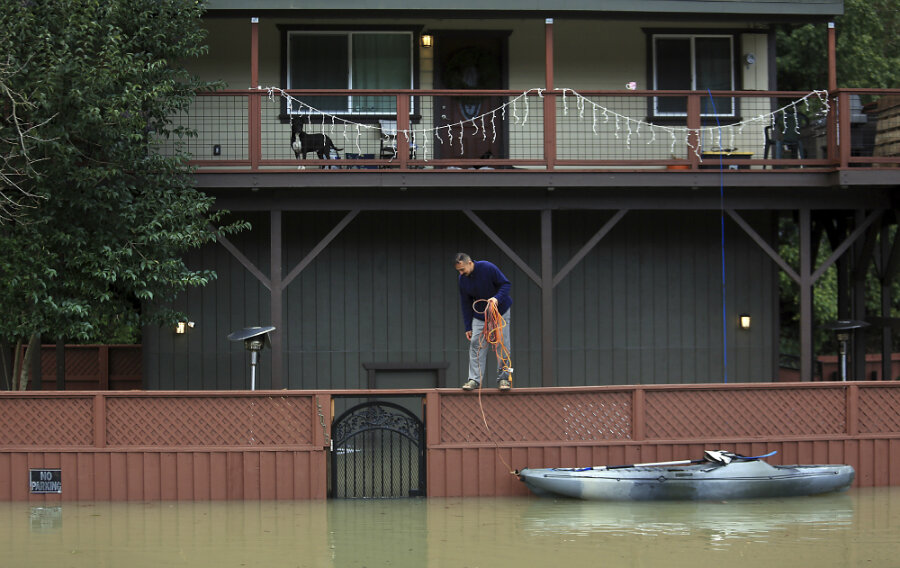From drought to floods, California staggers from one state of emergency to the next
Loading...
When it rains, it pours. In drought- and wildfire-scarred California, it also snows, hails, and gusts.
California Gov. Jerry Brown declared a state of emergency Monday in 50 out of California’s 58 counties, after a trio of winter storms brought a barrage of snow and rain that caused property damage, power outages, and four weather-related fatalities. Despite record-breaking precipitation, state officials fear the rains may not be enough to bring the years-long drought to a permanent close.
Some of the heaviest rains fell along the coast, where 3 to 4 inches fell in just six hours, shutting down roads and causing as many as 9,000 power outages in parts of Los Angeles and San Diego.
“Today was very intense,” said National Weather Service meteorologist Brett Albright to the Los Angeles Times on Sunday. “It’s not a normal event. It was definitely a culmination of the perfect circumstances: We had a very intense atmospheric river with a lot of moisture and an area of lift in the atmosphere right over coastal Los Angeles and Orange counties. It forced all of that moisture out.”
“It’s not often we see higher rainfall totals on the coast than in the mountains,” he continued.
But the mountains weren’t spared either, receiving heavy snowfall that closed schools and roads alike, triggering an avalanche and at least one roof collapse in Lake Tahoe.
Rockslides also closed roads in Malibu, but few mudslides materialized. A number of communities in the area were evacuated, but the most of the hillsides remained mercifully intact as of Sunday night.
Mudslide fears had been heightened by vegetation loss after last year’s wildfires, since plant roots keep topsoil from sliding down slopes during a heavy rainfall. California’s half-decade drought has left more than 100 million trees dead, creating tinderbox-like conditions that have led to several years with massive wildfires.
In this respect, January’s storms hold some good news for the thirsty state. The AP reports that after a wetter-than-average 2016, the Sierra Nevada snowpack is almost twice as large as usual, and Los Angeles has already gotten a year’s worth of rain in just a few weeks.
But will it be enough for California to resume to water consumption as usual?
In 2014, Governor Brown declared a water emergency in early 2014, ordering residents to cut water usage by 25 percent statewide, which led to a number of unpopular water-saving measures such as restricting sprinkler usage and car washing.
Some wonder if the recent storms will prompt the government to lift restrictions, but so far, officials are playing it safe. Last February, water regulators took a wait and see attitude: “Every drop saved today is one that we may be very glad we have tomorrow,” said Felicia Marcus, chair of the state water control board, in February 2016, after an unusually wet January.
Now, water experts are warning that a short-term focus on a few rainy months risks ignoring an underlying danger: wells that continue to run dry.
Rainwater can take years to travel through soil and bedrock down to underground aquifers. “Just because we get a bunch of rain today doesn't mean it solved our problem,” said Mike Maggiora of Maggiora Bros. Drilling Inc., to the AP. Well-drilling companies have reportedly had to venture as deep as 2,000 feet to hit water in some areas.
California, which produces nearly 25 percent of the country’s food, relies heavily on groundwater for irrigation, which accounts for as much as 80 percent of the state’s water use.
Facing ever-more-permanent water conservation measures, people are adjusting to a "water-lite" lifestyle, in some places replacing lush grass with more drought-friendly plants. Maintaining lawns "takes a lot of water. It takes a lot of work," Lisa Libby, a college history instructor, told the AP. "I'm not sure in this environment that it's necessary."
Meanwhile, others are finding silver linings in the current storm in the form of recreation such as paddleboarding, rafting, and in one case, driving a personal watercraft through the streets.
For now, the ordeal seems to be over. Wednesday’s forecast for Los Angeles was 50 degrees and sunny.
This article contains material from the Associated Press.








